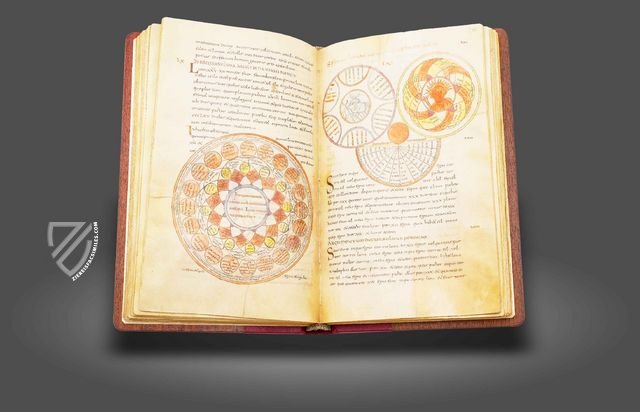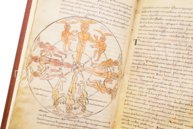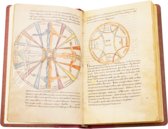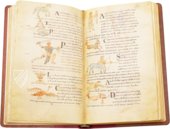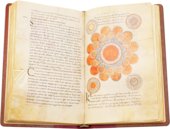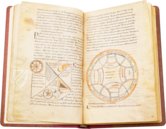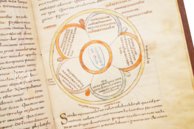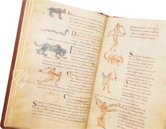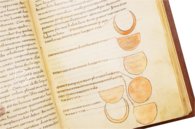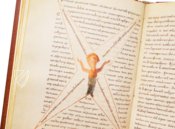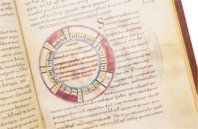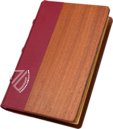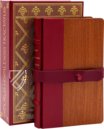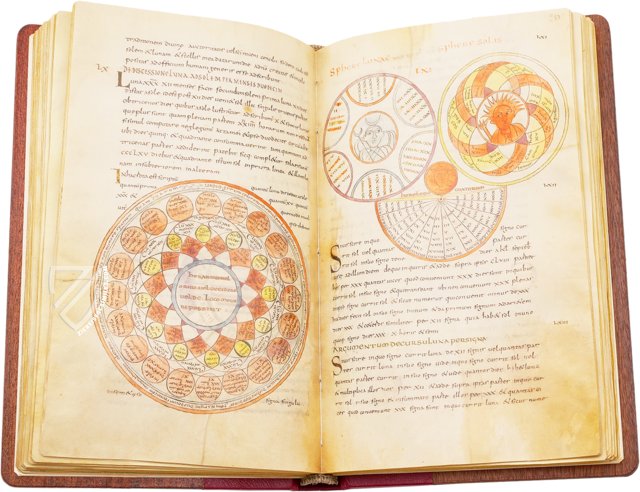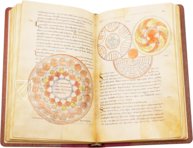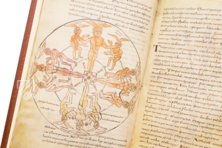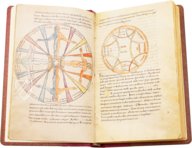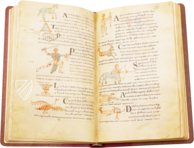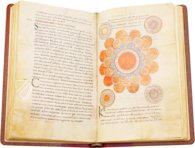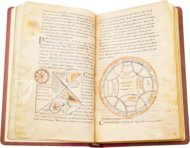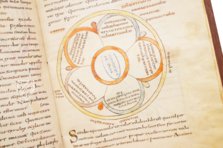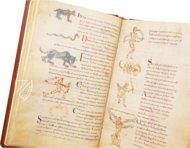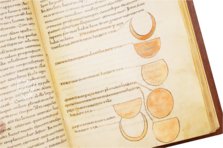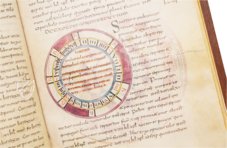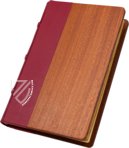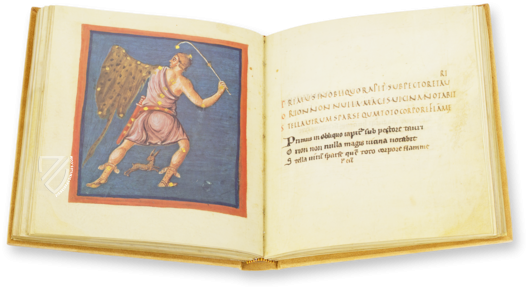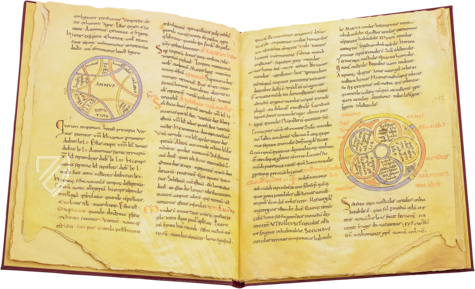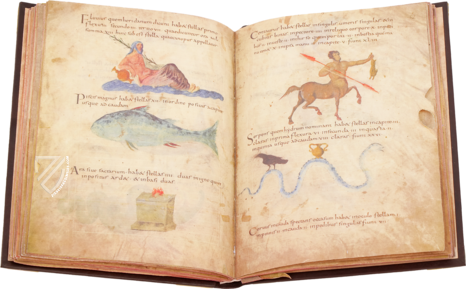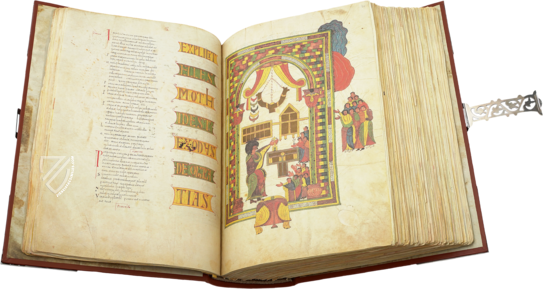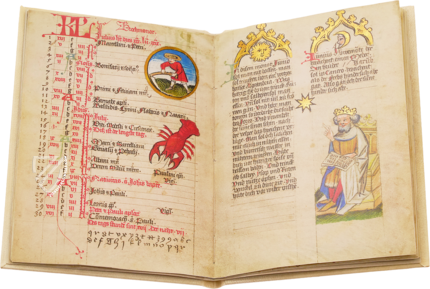Laon Computistical Miscellany
Publisher's price (new) 2,390 €
The Laon Computistical Miscellany is a Carolingian manuscript from Laon that combines two works by the influential scholar Isidore of Seville (560–636 AD) with Christian liturgical texts. Now preserved in the Médiathèque Suzanne-Martinet, this fascinating anthology was compiled over a period of nearly a century and brings together ancient knowledge and the teachings of the Church Fathers on the calculation and measurement of time, astronomy, as well as meteorology, and also on the devil and a holy life. The work is best known for Isidore's text known as the "Book of Wheels" De natura rerum, which is illuminated with numerous distinctive circle diagrams. With its total of more than 60 illustrative colored diagrams and miniatures of constellations, the Laon Computistical Miscellany is a wonderful early medieval testimony to the human urge to fathom the world and God's plan in it.
Laon Computistical Miscellany
Isidore of Seville (560–636 AD), also Isidorus Hispalensis, not only held the office of the Bishop of Seville, but was one of the most prolific and widely received authors of the Middle Ages. In his numerous Latin works, he adapted a great variety of ancient and Christian writings and dealt with diverse topics.
This anthology from the Médiathèque Suzanne-Martinet provides a wonderfully illuminated insight into the mind of the influential polymath on the threshold from antiquity to the Middle Ages. Compiled by four scribes between the second quarter and the end of the 9th century, probably in Laon, this fascinating anthology begins with Isidore's De natura rerum, Eng. "On the Nature of Things", which is followed by several excerpts from his Sententiae and various liturgical texts.
The "Book of Wheels"
De natura rerum is one of Isidore of Seville's most important works on natural history and was written by the bishop in the early 7th century. In it he treats subjects such as chronology, the measurement of time and the computus, the earth and the celestial bodies, as well as weather phenomena. Due to the many circle diagrams illustrating this knowledge, the work became known as the "Book of Wheels" in the Middle Ages. As was common at the time, Isidore compiled his information from previously published writings, in this case mainly from Latin, but also Greek, authors and the Church Fathers. Thus combining ancient knowledge with Christian theology, he himself became an authority for later medieval authors.
The Sentences of the "Last Scholar of Antiquity".
The writings of the Church Fathers also served Isidore as a basis for his Sententiae; more precisely, he made use of the works of two of them: Gregory and Augustine. In this work, the scholar compiled several theological texts that together make up a kind of handbook for the clergy, dealing, among other things, with the creation, the judgment of God, the nature of the devil, but also the duties of the clergy and God-pleasing behavior.
The World in Colorful Diagrams
An integral part of the anthology are the 60+ diagrams and miniatures. These are amazingly colorful and, in the case of the computistical and astronomical diagrams, highly precisely illuminated. Here, the colors serve not only for aesthetics and legibility, but in some cases also clearly reflect the content of the diagram in question. Thus, the color selection is by no means random and was extremely well considered.
Most densely illuminated, with 41 miniatures on only nine pages, is the part of the manuscript on the constellations. Here almost every short explanation of a constellation is accompanied by a small illustration. In it, the individual stars that make up the constellations are indicated by orange dots.
A Mysterious History
The exact circumstances of the origin of the early medieval manuscript have not been handed down. Thus, Laon can also only be presumed as the place of origin. However, researchers are relatively unanimous that the manuscript was created in the north of what is now France. Little is also known about its medieval and early modern history. The codex did not appear in the library of Notre-Dame de Laon Cathedral until the mid-17th century. After the French Revolution, it went to the Bibliothèque communale of Laon, now known as the Médiathèque Suzanne-Martinet.
Codicology
- Alternative Titles
- Isidor-Sammelband
- Size / Format
- 188 pages / 29.5 × 18.5 cm
- Origin
- France
- Date
- 9th century
- Epochs
- Style
- Language
- Script
- Carolingian minuscule Uncial
- Illustrations
- More than 60 miniatures and diagrams
- Content
- Astronomical and computistic miscellany with Isidore of Seville's "De natura rerum", excerpts from book III of his "Sententiae" as well as some liturgical texts
- Previous Owners
- Library of the Cathedral Notre-Dame de Laon
Laon Computistical Miscellany
Argo Navis
This constellation, first described by Ptolemy and now obsolete, shows the ship Argo, lt. argo navis. The depiction is based on the ancient saga of the Argonauts from Greek mythology, which tells of Jason's search for the Golden Fleece. He and his companions start the journey on the legendary fast ship Argo, after which they were called Argonauts.
Typical for the representation of the constellation are the curved bow of the ship and its two striking oars.
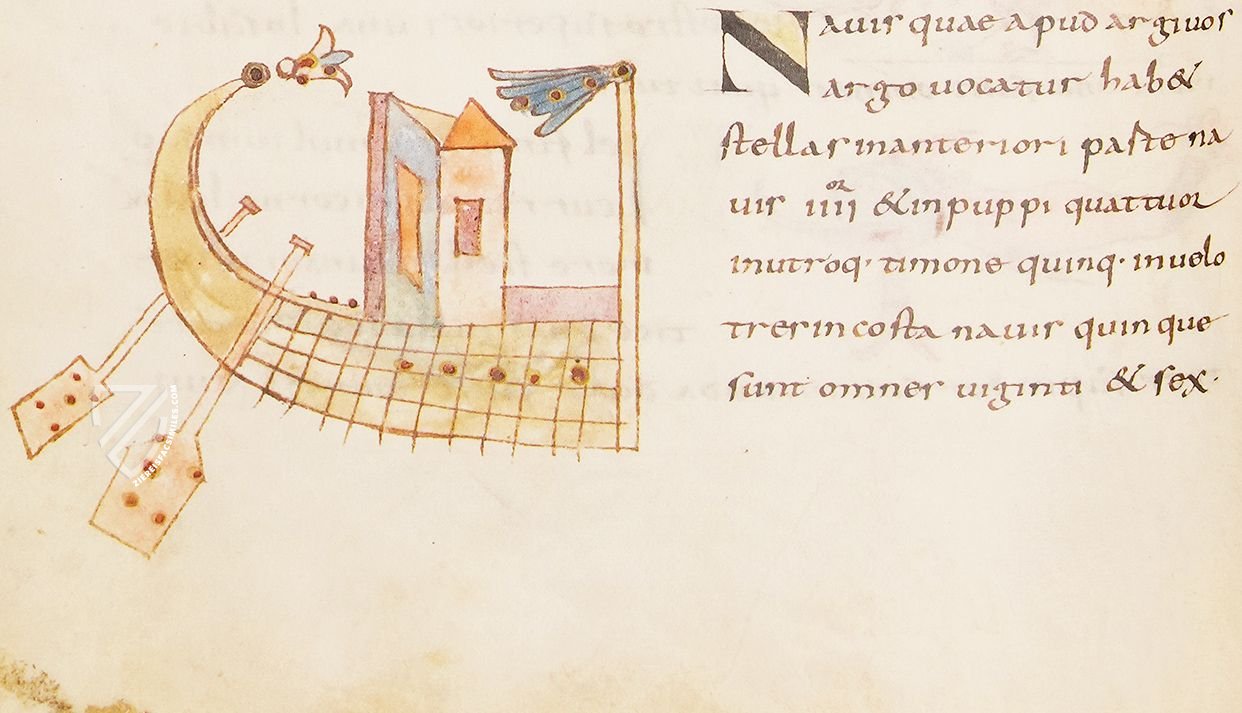
Laon Computistical Miscellany
The Four Seasons
This colorful diagram shows a wheel of twelve months, from the central section of which spring four schematically depicted female figures representing the seasons. With their outstretched arms, they each occupy three sections of the circle diagram, each corresponding to three months.
The figures and "spokes" of the wheel-like diagram are remarkably colorful. It is striking that the personifications of spring and autumn have been designed in two colors: blue on the left and orange on the right. This choice of color reflects the equinoxes in March and September and the transition from the warmly colored summertime on the right half of the diagram to the coolly colored wintertime on the left half. Thus, the personifications of summer and winter are also colored according to their season: light orange and icy blue.
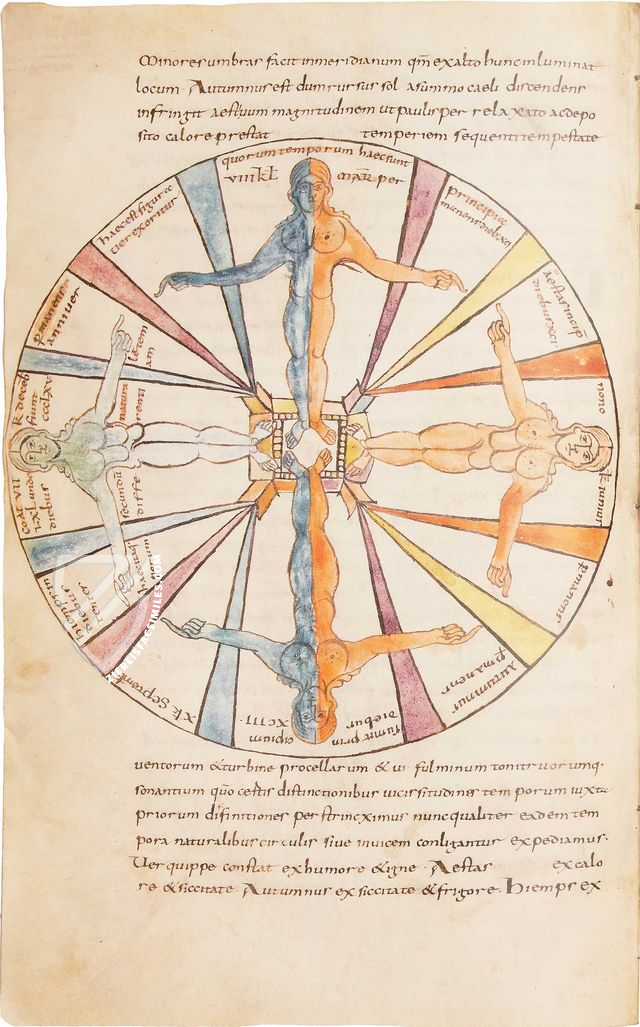
#1 Isidorus Hispalensis
Language: Spanish
Publisher's price (new) 2,390 €
- Treatises / Secular Books
- Apocalypses / Beatus
- Astronomy / Astrology
- Bestiaries
- Bibles / Gospels
- Chronicles / History / Law
- Geography / Maps
- Saints' Lives
- Islam / Oriental
- Judaism / Hebrew
- Single Leaf Collections
- Leonardo da Vinci
- Literature / Poetry
- Liturgical Manuscripts
- Medicine / Botany / Alchemy
- Music
- Mythology / Prophecies
- Psalters
- Other Religious Books
- Games / Hunting
- Private Devotion Books
- Other Genres
- Afghanistan
- Armenia
- Austria
- Belgium
- Colombia
- Croatia
- Cyprus
- Czech Republic
- Denmark
- Egypt
- Ethiopia
- France
- Germany
- Greece
- Hungary
- India
- Iran
- Iraq
- Israel
- Italy
- Japan
- Lebanon
- Luxembourg
- Mexico
- Morocco
- Netherlands
- Palestine
- Peru
- Poland
- Portugal
- Russia
- Serbia
- Spain
- Sri Lanka
- Sweden
- Switzerland
- Syria
- Turkey
- Ukraine
- United Kingdom
- United States
- Uzbekistan
- Aboca Museum
- Ajuntament de Valencia
- Akademie Verlag
- Akademische Druck- u. Verlagsanstalt (ADEVA)
- Aldo Ausilio Editore - Bottega d’Erasmo
- Alecto Historical Editions
- Alkuin Verlag
- Almqvist & Wiksell
- Amilcare Pizzi
- Andreas & Andreas Verlagsbuchhandlung
- Archa 90
- Archiv Verlag
- Archivi Edizioni
- Arnold Verlag
- ARS
- Ars Magna
- ArtCodex
- AyN Ediciones
- Azimuth Editions
- Badenia Verlag
- Bärenreiter-Verlag
- Belser Verlag
- Belser Verlag / WK Wertkontor
- Benziger Verlag
- Bernardinum Wydawnictwo
- BiblioGemma
- Biblioteca Apostolica Vaticana (Vaticanstadt, Vaticanstadt)
- Bibliotheca Palatina Faksimile Verlag
- Bibliotheca Rara
- Boydell & Brewer
- Bramante Edizioni
- Bredius Genootschap
- Brepols Publishers
- British Library
- C. Weckesser
- Caixa Catalunya
- Canesi
- CAPSA, Ars Scriptoria
- Caratzas Brothers, Publishers
- Carus Verlag
- Casamassima Libri
- Chavane Verlag
- Christian Brandstätter Verlag
- Circulo Cientifico
- Club Bibliófilo Versol
- Club du Livre
- CM Editores
- Collegium Graphicum
- Collezione Apocrifa Da Vinci
- Comissão Nacional para as Comemorações dos Descobrimentos Portugueses
- Coron Verlag
- Corvina
- CTHS
- D. S. Brewer
- Damon
- De Agostini/UTET
- De Nederlandsche Boekhandel
- De Schutter
- Deuschle & Stemmle
- Deutscher Verlag für Kunstwissenschaft
- DIAMM
- Droz
- E. Schreiber Graphische Kunstanstalten
- Ediciones Boreal
- Ediciones Grial
- Ediclube
- Edições Inapa
- Edilan
- Editalia
- Edition Deuschle
- Edition Georg Popp
- Edition Leipzig
- Edition Libri Illustri
- Editiones Reales Sitios S. L.
- Éditions de l'Oiseau Lyre
- Editions Medicina Rara
- Editorial Casariego
- Editorial Mintzoa
- Editrice Antenore
- Editrice Velar
- Edizioni Edison
- Egeria, S.L.
- Eikon Editores
- Electa
- Emery Walker Limited
- Enciclopèdia Catalana
- Eos-Verlag
- Ephesus Publishing
- Ernst Battenberg
- Eugrammia Press
- Extraordinary Editions
- Fackelverlag
- Facsimila Art & Edition
- Facsimile Editions Ltd.
- Facsimilia Art & Edition Ebert KG
- Faksimile Verlag
- Feuermann Verlag
- Folger Shakespeare Library
- Franco Cosimo Panini Editore
- Friedrich Wittig Verlag
- Fundación Hullera Vasco-Leonesa
- G. Braziller
- Gabriele Mazzotta Editore
- Gebr. Mann Verlag
- Gesellschaft für graphische Industrie
- Getty Research Institute
- Giovanni Domenico de Rossi
- Giunti Editore
- Graffiti
- Grafica European Center of Fine Arts
- Guido Pressler
- Guillermo Blazquez
- Gustav Kiepenheuer
- H. N. Abrams
- Harrassowitz
- Helikon
- Hendrickson Publishers
- Henning Oppermann
- Herder Verlag
- Hes & De Graaf Publishers
- Hoepli
- Holbein-Verlag
- Hortus Deliciarum
- Houghton Library
- Hugo Schmidt Verlag
- Idion Verlag
- Il Bulino, edizioni d'arte
- ILte
- Imago
- Insel Verlag
- Instituto Nacional de Antropología e Historia
- Istituto dell'Enciclopedia Italiana - Treccani
- Istituto Ellenico di Studi Bizantini e Postbizantini
- Istituto Geografico De Agostini
- Istituto Poligrafico e Zecca dello Stato
- Italarte Art Establishments
- J. Thorbecke
- Jan Thorbecke Verlag
- Johnson Reprint Corporation
- Josef Stocker
- Josef Stocker-Schmid
- Jugoslavija
- Karl W. Hiersemann
- Kasper Straube
- Kaydeda Ediciones
- Kindler Verlag / Coron Verlag
- Kodansha International Ltd.
- Konrad Kölbl Verlag
- Kurt Wolff Verlag
- La Liberia dello Stato
- La Linea Editrice
- La Meta Editore
- Lambert Schneider
- Landeskreditbank Baden-Württemberg
- Leo S. Olschki
- Les Incunables
- Library of Congress
- Libreria Musicale Italiana
- Lichtdruck
- Lito Immagine Editore
- Lumen Artis
- Lund Humphries
- M. Moleiro Editor
- Maison des Sciences de l'homme et de la société de Poitiers
- Manuscriptum
- Martinus Nijhoff
- Maruzen-Yushodo Co. Ltd.
- MASA
- McGraw-Hill
- Militos
- Millennium Liber
- Müller & Schindler
- Nahar and Steimatzky
- National Library of Wales
- Neri Pozza
- Nova Charta
- Oceanum Verlag
- Odeon
- Orbis Mediaevalis
- Orbis Pictus
- Österreichische Staatsdruckerei
- Oxford University Press
- Pageant Books
- Parzellers Buchverlag
- Patrimonio Ediciones
- Pattloch Verlag
- PIAF
- Pieper Verlag
- Plon-Nourrit et cie
- Prestel Verlag
- Princeton University Press
- Prisma Verlag
- Priuli & Verlucca, editori
- Pro Sport Verlag
- Propyläen Verlag
- Pytheas Books
- Quaternio Verlag Luzern
- Reales Sitios
- Recht-Verlag
- Reichert Verlag
- Reichsdruckerei
- Riehn & Reusch
- Roberto Vattori Editore
- Rosenkilde and Bagger
- Roxburghe Club
- Salerno Editrice
- Sarajevo Svjetlost
- Schöck ArtPrint Kft.
- Scolar Press
- Scrinium
- Scripta Maneant
- Scriptorium
- Siloé, arte y bibliofilia
- SISMEL - Edizioni del Galluzzo
- Sociedad Mexicana de Antropología
- Société des Bibliophiles & Iconophiles de Belgique
- Soncin Publishing
- Sorli Ediciones
- Stainer and Bell
- Studer
- Styria Verlag
- Sumptibus Pragopress
- Szegedi Tudomànyegyetem
- Taberna Libraria
- Tarshish Books
- Taschen
- Tempus Libri
- Testimonio Compañía Editorial
- Thames and Hudson
- The Clear Vue Publishing Partnership Limited
- The Facsimile Codex
- The Folio Society
- The Marquess of Normanby
- The Richard III and Yorkist History Trust
- Tip.Le.Co
- TouchArt
- TREC Publishing House
- TRI Publishing Co.
- Trident Editore
- Typis Regiae Officinae Polygraphicae
- Union Verlag Berlin
- Universidad de Granada
- University of California Press
- University of Chicago Press
- Urs Graf
- Vallecchi
- Van Wijnen
- VCH, Acta Humaniora
- VDI Verlag
- VEB Deutscher Verlag für Musik
- Verlag Anton Pustet / Andreas Verlag
- Verlag Bibliophile Drucke Josef Stocker
- Verlag der Münchner Drucke
- Verlag für Regionalgeschichte
- Verlag Styria
- Vicent Garcia Editores
- W. Turnowsky
- Waanders Printers
- Wiener Mechitharisten-Congregation (Wien, Österreich)
- Wissenschaftliche Buchgesellschaft
- Wydawnictwo Dolnoslaskie
- Xuntanza Editorial
- Zakład Narodowy
- Zollikofer AG

